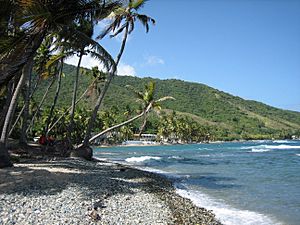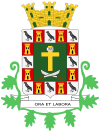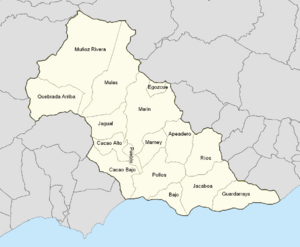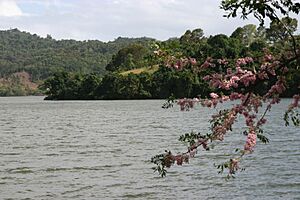Patillas, Puerto Rico facts for kids
Quick facts for kids
Patillas
Municipio Autónomo de Patillas
|
|||
|---|---|---|---|
|
Town and Municipality
|
|||

Beach in Patillas
|
|||
|
|||
| Nicknames:
"La Esmeralda del Sur", "Los Leones"
|
|||
| Anthem: "Patillenses" | |||

Map of Puerto Rico highlighting Patillas Municipality
|
|||
| Sovereign state | |||
| Commonwealth | |||
| Settled | 1760 | ||
| Founded | October 31, 1811 | ||
| Founded by | Marcos Xiorro | ||
| Barrios | |||
| Area | |||
| • Total | 59.3 sq mi (153.62 km2) | ||
| • Land | 48.3 sq mi (125 km2) | ||
| • Water | 11.1 sq mi (28.62 km2) | ||
| Population
(2020)
|
|||
| • Total | 15,985 | ||
| • Rank | 66th in Puerto Rico | ||
| • Density | 269.56/sq mi (104.055/km2) | ||
| Demonym(s) | Patillenses | ||
| Time zone | UTC−4 (AST) | ||
| ZIP Code |
00723
|
||
| Area code(s) | 787/939 | ||
| Major routes | |||
Patillas is a beautiful beach town and municipality in Puerto Rico. It is located on the southeastern coast. You can find it south of San Lorenzo, west of Yabucoa and Maunabo, and east of Guayama and Arroyo.
Patillas is divided into 15 areas called barrios, plus the main downtown area known as Patillas Pueblo. This town is also part of the Guayama Metropolitan Statistical Area.
Contents
History of Patillas
People from Europe started settling in the Patillas area around 1760. However, the town itself wasn't officially started until 1811. In 1841, a big fire happened in Patillas, causing a lot of damage.
Patillas is on the southeastern coast of Puerto Rico. A sugar cane mill was built here because the coastal land was great for farming. This mill brought jobs and money, which was the main reason the town was founded in 1811. Doña Adelina Cintrón, who owned a farm called "La Finca Patillas," gave about 8 acres of her land to help start the town. Many people then moved to the west side of the new town, to an area called Cacao Bajo.
After the Spanish–American War, Spain gave Puerto Rico to the United States in 1898. In 1899, the U.S. government counted the people in Patillas and found that 11,163 people lived there.
On September 20, 2017, Hurricane Maria hit Puerto Rico very hard. In Patillas, the power went out, and 341 homes were completely destroyed. Strong winds and heavy rain caused many landslides, making roads impossible to use.
Geography of Patillas
Patillas is located on the southeastern coast of Puerto Rico. Even though it's known for its coastal valleys, some parts of the town are mountainous. The Sierra de Cayey mountains are to the north, and the Sierra de Guardarraya mountains are to the east.
Barrios of Patillas
Like all towns in Puerto Rico, Patillas is divided into smaller areas called barrios. The main town buildings, the central square, and a large Catholic church are in the barrio known as "el pueblo".
Sectors and Communities
Barrios are often divided even further into smaller areas called sectores (which means sectors in English). These sectors can have different names like urbanización or barriada.
There are also "Special Communities of Puerto Rico" (Comunidades Especiales de Puerto Rico). These are areas where people might face challenges. In Patillas, some of these special communities include Sector Barro Blanco in Bajos, Sector Higüero in Jacaboa, Sector Recio in Guardarraya, and Quebrada Arriba.
Things to See and Do in Patillas
Patillas has 28 beaches, but some, like Inches Beach, can be dangerous for swimming.
Landmarks and Places of Interest
Some popular spots to visit in Patillas are:
- Charco Azul
- Los Tres Chorros
- Carite State Forest
- Escondida Beach
- Guardarraya Beach
- Charco de la Vuelta
- Villa Pesquera Beach
- Lago de Patillas (Patillas Lake)
- Guavate Forest, which has places to eat near Cayey
Festivals and Events
Patillas celebrates its patron saint festival in August. This event, called Fiestas Patronales de San Benito Abad, is a religious and cultural celebration. It usually includes parades, games, local crafts, fun rides, traditional food, and live music.
Other fun events in Patillas include:
- Emerald of the South Carnival – May
- Southeast Marathon – November
- Wheat Flour Festival – December
- Christmas Parade – December
Bodies of Water
Several rivers flow through Patillas, such as Río de Apeadero, Río Chico, Río Grande de Patillas, Río Jacaboa, and Río Marín. There are also many smaller creeks.
The Lago Patillas, or Patillas Lake, is a man-made lake built in 1914. The Patillas and Marín Rivers flow into this lake. It's a great spot for fishing and other water activities.
Economy of Patillas
In 2021, Patillas was known as one of the main areas in Puerto Rico for growing plantains. This shows how important farming is to the town's economy.
Population of Patillas
| Historical population | |||
|---|---|---|---|
| Census | Pop. | %± | |
| 1900 | 11,163 | — | |
| 1910 | 14,448 | 29.4% | |
| 1920 | 14,284 | −1.1% | |
| 1930 | 14,178 | −0.7% | |
| 1940 | 17,319 | 22.2% | |
| 1950 | 18,851 | 8.8% | |
| 1960 | 17,106 | −9.3% | |
| 1970 | 17,828 | 4.2% | |
| 1980 | 17,774 | −0.3% | |
| 1990 | 19,633 | 10.5% | |
| 2000 | 20,152 | 2.6% | |
| 2010 | 19,277 | −4.3% | |
| 2020 | 15,985 | −17.1% | |
| U.S. Decennial Census 1899 (shown as 1900) 1910-1930 1930-1950 1960-2000 2010 2020 |
|||
In 2000, Patillas had about 20,152 people living there. The population density was about 426 people per square mile. The number of people living in Patillas has changed over the years, with some declines in the 1960s, 1990s, and more recently in the 2010 and 2020 census.
People in Puerto Rico often have ancestors from different backgrounds, including Indigenous, European, or African roots. In 2000, about 67.7% of people in Patillas identified as having European or white origins. About 12.3% identified as Afro Puerto Rican, and 0.5% identified as Amerindian.
| Race - Patillas, Puerto Rico - 2000 Census | ||
|---|---|---|
| Race | Population | % of Total |
| White | 13,633 | 67.7% |
| Black/African American | 2,482 | 12.3% |
| American Indian and Alaska Native | 95 | 0.5% |
| Asian | 23 | 0.1% |
| Native Hawaiian/Pacific Islander | 7 | 0.0% |
| Some other race | 1,452 | 7.2% |
| Two or more races | 2,460 | 12.2% |
Education in Patillas
Patillas has many public and private schools. The Puerto Rico Department of Education is in charge of public schools here.
Symbols of Patillas
The town of Patillas has its own official flag and coat of arms. These symbols tell a story about the town's history and values.
The Flag of Patillas
The flag of Patillas has four green rectangles in the corners. These rectangles represent the green valleys and mountains of the town. A golden cross separates these green rectangles. This cross stands for the town's strong faith in its religious patron, "El Santo Cristo de la Salud." In the very center of the golden cross, there is a beautiful emerald. This is why Patillas is nicknamed "La Esmeralda del Sur," meaning "The Emerald of the South."
The flag's design was created by Pedro de Pedro in 1977. Each symbol on the flag was explained by Pedro J. Rivera Arbolay.
The Coat of Arms
The coat of arms of Patillas has several interesting symbols:
- A crow holding a piece of bread in its beak. This represents a story where a bird saved San Benito Abad, the town's patron saint, from being poisoned.
- A castle with three windows. This symbolizes the story of Santa Barbara, who was a patron of Patillas in its early days. It also shows devotion to the Holy Trinity.
- A cross, which represents Santo Cristo de la Salud.
- Two crossed machetes below the cross. These stand for the hard work of the peasants in the sugar cane fields, which was important for the town's early economic development.
- Three towers at the top. These show that Patillas is recognized as a town.
- A watermelon leaf. This fruit, called patillas in Spanish, grew a lot in the western part of the area. This is how the town got its name!
- The motto "Ora et Labora," which means "Pray and Work." This was the motto of the religious order of San Benito Abad.
The Name "Patillas"
The name Patillas comes from an old local name for a type of watermelon. Because this fruit grew in huge amounts in the area, and because of the land given by the original owner, the town was named Patillas.
The Emerald of the South
Patillas is known as the "Emerald of the South." This nickname comes from the stunning green color of its mountains, especially when the sun shines on them. Even though it's a mountain town, it also has beautiful beaches. Patillas offers many natural places to relax, like its beaches, forests, and the Patillas Lake. People often go fishing in the coastal waters and the lake.
Anthem: "Patillenses"
The official anthem of Patillas is called "Patillenses," written by Andrés Plaud Soto.
"Patillenses, ¡Veis la luz, de la antorcha y su esplendor, que ilumina en noble gesta de amor... la ruta que recorrió, el que por ti ayer luchó, en las lides de los campos del honor!
No olvidéis otras proezas en las Artes del Saber, producto de otros hermanos, que este pueblo vio nacer. Sus conquistas celebramos con solemne admiración: ¡Hosana mis compueblanos... Les brindo mi corazón!"
Famous People from Patillas
Many notable people have come from Patillas:
- David "Quique" Bernier – A dentist, athlete, and politician who ran for governor in 2016. He held many important public service jobs in Puerto Rico.
- Francisco Cervoni-Gely – A poet, writer, journalist, and political figure. He wrote plays and poetry.
- Gaspar Cochran – A community leader in Patillas who started the first "A" class baseball team, the Lions of Patillas. He also directed the annual Patron Saint Festivals for 20 years.
- José Dávila Ricci – A political figure and journalist. He was part of the Liberal Party and founded the Puerto Rico Journalism Association. He worked for several newspapers and magazines.
- Edmundo Disdier – A talented musician and composer.
- Olga D. González-Sanabria – A scientist and inventor.
- Luisa Lebrón Burgos – A judge and politician who served in the Senate of Puerto Rico from 1993 to 2000. She is now a judge in the Carolina region.
- Ramón Lebrón-Rodríguez – A writer known for his works on legal history and biographies.
- Angelita Lind – An amazing athlete who won many medals in major sports events, including the Central American and Caribbean Games, Pan American Games, and the Olympics.
- Emilio "Millito" Navarro – Born in Patillas in 1905, he was the first Puerto Rican to play baseball in the Negro leagues.
- Paulino Rodríguez – A writer who wrote children's stories, a novel, poetry, and a history book about Patillas.
- Cirilo Tirado Rivera – A politician.
- Awilda Villarini – A composer and pianist.
See also
 In Spanish: Patillas (Puerto Rico) para niños
In Spanish: Patillas (Puerto Rico) para niños





